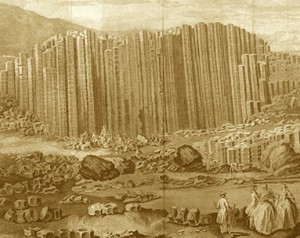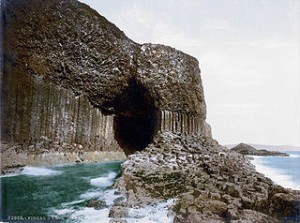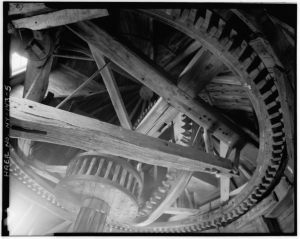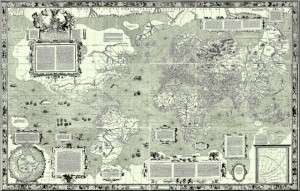Giants and a Rock Made of Cheese
I’m not much of a fiction reader, but I did come across a rather entertaining folk tale a while back while researching historical ramps. There is a rock formation in Northern Ireland called the Giant’s Causeway, made of thousands of hexagonal basalt columns, which can form when lava cools slowly.

Giant’s Causeway
Local legend tells that the giant Fionn mac Cumhaill built the Giant’s Causeway—across the sea from Ireland all the way to Scotland—in response to a challenge from the Scottish giant Benandoner. When Fionn saw Benandoner, though, and realized how much bigger he was, he would have fled, but his wife, Oona, had him dress up as a baby. She tucked him into a crib, then began cooking.
When Benandoner arrived across the causeway, Oona told him that he was away, and invited the Scottish giant inside to wait. When he saw Fionn in the crib he decided that, to have a baby that big, Fionn must be truly enormous. Benandoner then tried to intimidate Oona by crushing rocks with his pinky finger, but she just smiled at him and handed a rock to Fionn, who crushed it to cheese. (It helped, of course, that Fionn’s rock had always been cheese).
Oona then gave Benandoner and Fionn each a griddle-cake (Irish name for a pancake). Benandoner bit into his and broke a tooth, which probably had something to do with the pan Oona had baked into it. Fionn, meanwhile, ate his with gusto.

Fingal’s Cave
Oona invited Benandoner to feel how sharp and strong the baby’s teeth were. Benandoner, feeling his broken tooth and watching Fionn eat his griddle-cake, declined. He politely begged leave of Oona. He then fled across the causeway, destroying it behind him, not wanting to meet the father of that monstrous baby. Only the two ends were left inact—the columns of the Giant’s causeway, and the columns of Fingal’s Cave, in Scotland (which has plenty of legends of its own).
Fionn hopped out of the cradle, praising Oona’s wit, bravery, and beauty. Oona just laughed and handed him a broom to clean up the broken rocks and food.
Civilization and Roads
Good roads are absolutely essential to civilization. Many of the most successful countries in history were hugely dependent on their roads for their success. To my mind, the two ancient civilizations with the most impressive road systems are the Roman and Incan Empires.
The Incan road system, the shorter of the two, was still more than 20,000 miles long. The Incans did such a good job that much of the road is still useable today—even segments that haven’t seen a lick of maintenance in four centuries—though more than 75 percent of it has been destroyed by Spaniards and modern construction. The Incan roads were heavily used by the Chasquis, a network of runners that sent messages and valuable, lightweight goods across the empire, using relays. The individual Chasqui ran as much as a hundred and fifty miles per day through the mountains—that’s six marathons. The roads were also used heavily by normal traffic: trade on alpacas and llamas, etc.

Ancient Roman Rest Stop?
Rome’s roads are, without a doubt, the best known of all ancient road systems—not surprising, since it’s the best known ancient civilization of all time. There were 250,000 miles of roads in the network, an order of magnitude larger than the Incan network.
It’s not to say that the Incan network wasn’t an incredible piece of engineering and architecture; it was, but the Romans were just utterly obsessed with road building. There is an astonishing number of these roads still in use, whether covered in modern construction or even in their original form.
Yes, roads are an absolutely elemental part of civilization. I should put this all into perspective, though. America has nearly four MILLION miles of roads. Our population dwarfs Ancient Rome or the Incan Empire and, of course, the American population alone is greater than that of the entire world during either of those time periods.
So, next time you’re upset about construction, just sit back and think about that before complaining. It’s a small price to pay. (Unless it’s in front of your house early in the morning. That’s just the worst.)
Tilting at Windmill Research
As I was fishing with the grandkids recently, the eldest asked me why windmills look the way they do these days, instead of the way they looked in the old days and in cartoons.

Pantigo Windmill, East Hampton
I didn’t know, so when we got home later that day I helped him look it up. I’d rather admit I don’t know something to a kid and then help him research than just make something up or just brush off the question. Plus, it helps teach kids how to learn things themselves.
The answers regarding the windmills turned out to be pretty interesting, even if a lot of the math was still beyond him.
First off, the arms on a windmill are long and thin these days in order to function like a wing, which drastically increases their efficiency. So far, pretty straightforward stuff.
Next, and the most complicated: why they have three arms. Turns out there’s a whole load of math involved. A single arm would be most efficient, but wouldn’t produce much power. Two arms at 180 degrees actually puts considerable strain on the hub of the windmill, which reduces the energy it produces and causes long-term strain and damage.
Three blades solves all of these problems; using more than three starts to reduce efficiency. That’s not the only reason, of course. It also costs quite a bit more to build windmills with a larger number of blades.
The reason most windmill blades are a certain length is actually due to the shipping industry. Most of the blades are at the maximum length that can be carried by a semi on the highway. While there are some longer blades that can be transported by train and then by helicopter, they’re expensive and difficult to produce and move.
As for why windmills are painted white? My grandson actually figured that one out before we looked it up, which made me proud: The white paint reduces the heating on the windmill parts.
Plus, it just looks nice.
Maps and Oranges
When I have a choice of what map I want to use, I’ll always pick a globe.
Flat maps all have one major problem: they’re trying to display a round globe.
Here’s an experiment. Cut an unpeeled orange in half, then take out the insides without ripping the peel. Then try to push the peel flat on a surface.

Mercator Projection: 1569
Mapmakers have developed a number of strategies for dealing with the problem. They’re referred to as map projections, and the most commonly used is the Mercator Projection. It’s by far one of the most common map projections you’ll run into.
The Mercator Projection is quite useful and works great for navigation…but at the cost of grossly misrepresenting the size of certain landmasses, especially closer to the poles. The best way to picture this is by stretching out that orange peel. There’s going to be quite a bit of distortion.
Greenland is the biggest offender. Greenland in real life is 1/14th the size of Africa, and 1/3rd the size of Australia, but it is grossly inflated on the Mercator Projection and is actually portrayed as larger than Australia. Africa, meanwhile, is shrunk down until it appears the same size as Greenland on the map. This has actually produced quite a bit of academic and political controversy over the years. The Mercator is drifting out of popularity these days.
Another common map projection is the Goode homolosine projection. This one is the equivalent of cutting the orange peel to make it look flat; in fact, it’s often called the orange peel map. While the Goode homolosine projection does a much better job of representing the continents without distorting them, it does cut Greenland in half and, well… you can see what it looks like.
Given the choice, I’m always going to use a globe. Unfortunately, they’re less than perfectly portable.





